Input interpretation

ethane
Chemical names and formulas

formula | CH_3CH_3 Hill formula | C_2H_6 name | ethane alternate names | bimethyl | dimethyl | ethyl hydride | Freon 170 | methylmethane | R-170 mass fractions | C (carbon) 79.9% | H (hydrogen) 20.1%
Lewis structure
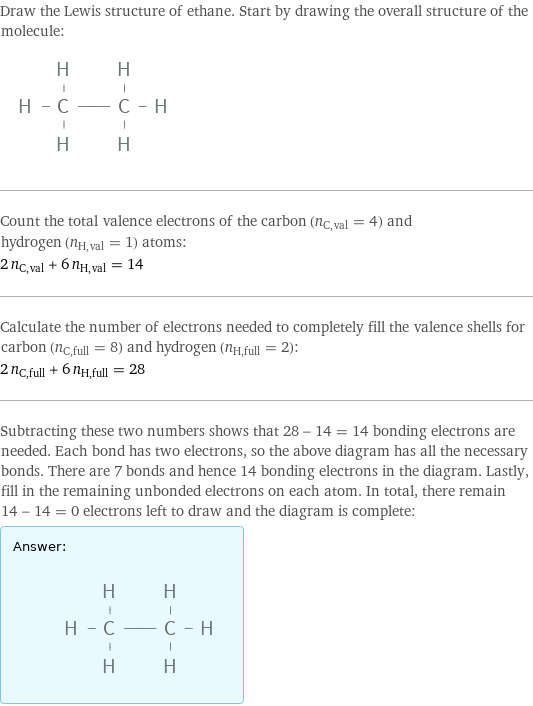
Draw the Lewis structure of ethane. Start by drawing the overall structure of the molecule: Count the total valence electrons of the carbon (n_C, val = 4) and hydrogen (n_H, val = 1) atoms: 2 n_C, val + 6 n_H, val = 14 Calculate the number of electrons needed to completely fill the valence shells for carbon (n_C, full = 8) and hydrogen (n_H, full = 2): 2 n_C, full + 6 n_H, full = 28 Subtracting these two numbers shows that 28 - 14 = 14 bonding electrons are needed. Each bond has two electrons, so the above diagram has all the necessary bonds. There are 7 bonds and hence 14 bonding electrons in the diagram. Lastly, fill in the remaining unbonded electrons on each atom. In total, there remain 14 - 14 = 0 electrons left to draw and the diagram is complete: Answer: | |
3D structure

3D structure
Basic properties
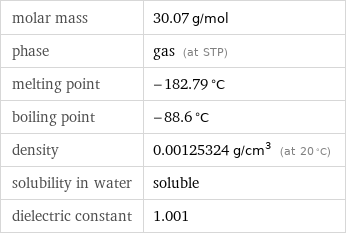
molar mass | 30.07 g/mol phase | gas (at STP) melting point | -182.79 °C boiling point | -88.6 °C density | 0.00125324 g/cm^3 (at 20 °C) solubility in water | soluble dielectric constant | 1.001
Gas properties (at STP)
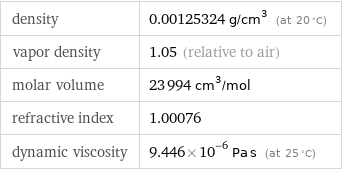
density | 0.00125324 g/cm^3 (at 20 °C) vapor density | 1.05 (relative to air) molar volume | 23994 cm^3/mol refractive index | 1.00076 dynamic viscosity | 9.446×10^-6 Pa s (at 25 °C)
Units

Thermodynamic properties

specific heat capacity c_p | gas | 1.746 J/(g K) molar heat capacity c_p | gas | 52.5 J/(mol K) specific free energy of formation Δ_fG° | gas | -1.064 kJ/g molar free energy of formation Δ_fG° | gas | -32 kJ/mol specific heat of formation Δ_fH° | gas | -2.793 kJ/g molar heat of formation Δ_fH° | gas | -84 kJ/mol specific entropy S° | gas | 7.632 J/(g K) molar entropy S° | gas | 229.5 J/(mol K) molar heat of vaporization | 70.4 kJ/mol | specific heat of vaporization | 2.34 kJ/g | molar heat of combustion | 1561 kJ/mol | specific heat of combustion | 51.91 kJ/g | molar heat of fusion | 2.72 kJ/mol | specific heat of fusion | 0.0905 kJ/g | thermal conductivity | 0.02036 W/(m K) | critical temperature | 305.32 K | critical pressure | 4.88 MPa | (at STP)
Phase diagram
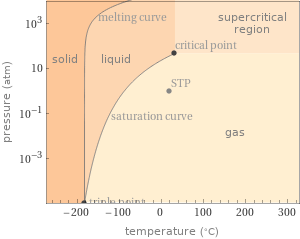
Phase diagram
Units

Chemical identifiers
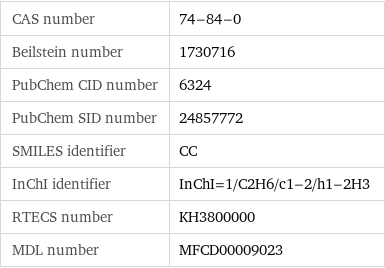
CAS number | 74-84-0 Beilstein number | 1730716 PubChem CID number | 6324 PubChem SID number | 24857772 SMILES identifier | CC InChI identifier | InChI=1/C2H6/c1-2/h1-2H3 RTECS number | KH3800000 MDL number | MFCD00009023
NFPA label

NFPA label
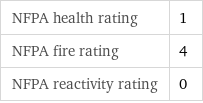
NFPA health rating | 1 NFPA fire rating | 4 NFPA reactivity rating | 0
Safety properties

flash point | -135 °C autoignition point | 515 °C lower explosive limit | 3% (concentration in air) upper explosive limit | 12.5% (concentration in air)

DOT hazard class | 2.1 DOT numbers | 1035